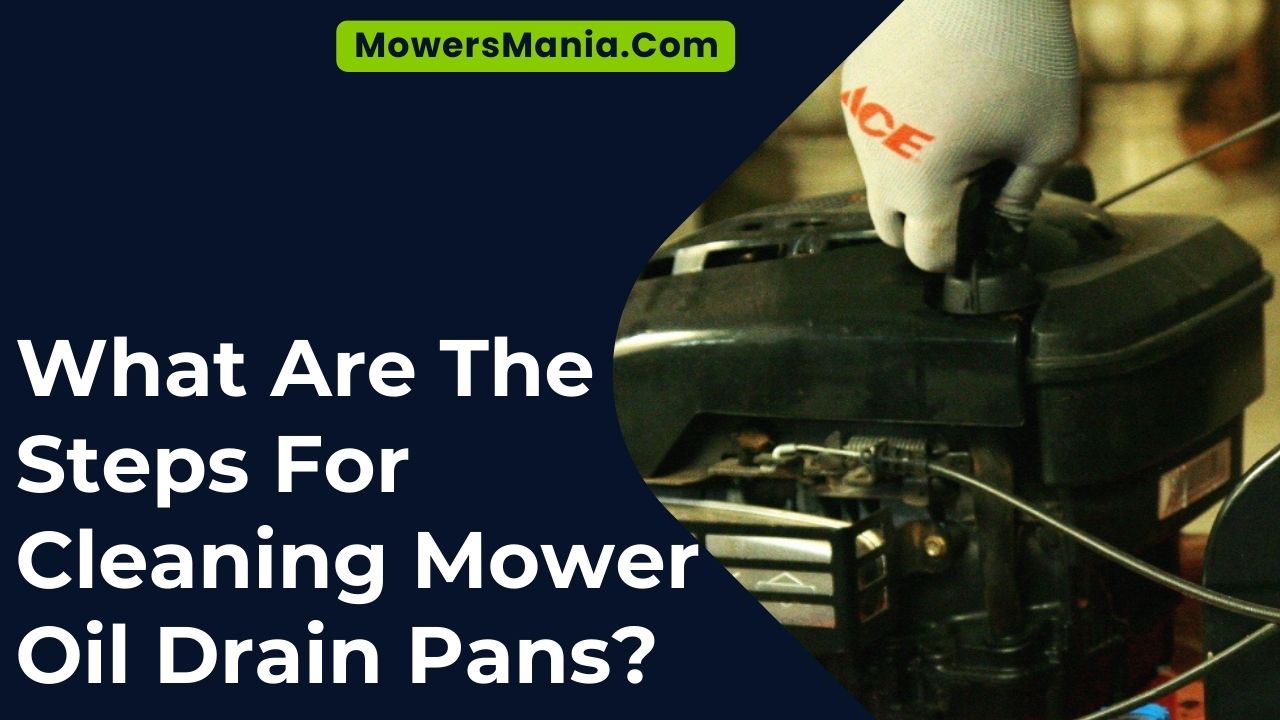Want to keep your mower running smoothly? Wondering how to clean the oil drain pan? It’s a simple process that can be done in just a few steps.
- First, gather the tools and materials you’ll need.
- Then, drain the oil from the mower and remove the oil drain pan.
- Once removed, give the oil drain pan a thorough cleaning.
- After that, reinstall the oil drain pan and dispose of the used oil properly.
By following these steps, you can ensure that your mower’s oil drain pan stays clean and in good working condition.
Gather Necessary Tools and Materials
Before you begin cleaning the mower oil drain pans, you should gather the necessary tools and materials.
Start by getting a pair of rubber gloves to protect your hands from the oil and any sharp edges. You’ll also need a socket wrench or an adjustable wrench to loosen the drain plug.
It’s essential to have an oil pan or a container to collect the old oil. Make sure the container is large enough to hold all the oil from the mower. Additionally, have some rags or paper towels on hand to wipe up any spills or drips.
You may also want to have a funnel to help pour the old oil into a storage container for proper disposal.
Lastly, it’s crucial to have the appropriate type and amount of new oil for your mower. Check the mower’s manual or the manufacturer’s guidelines to ensure you’re using the correct oil.
Once you have all these tools and materials gathered, you’ll be ready to proceed with cleaning the mower oil drain pans.
Drain the Oil From the Mower
Use a socket wrench or adjustable wrench to loosen the drain plug and drain the oil from the mower.
- Position a drain pan underneath the mower to catch the oil as it drains out.
- Once the drain plug is loosened, carefully remove it and allow the oil to flow into the drain pan.
- Tilt the mower slightly to ensure that all the oil is drained from the engine.
- After the oil has completely drained, securely tighten the drain plug back into place using the wrench.
Remember to handle the drained oil properly by disposing of it at a designated recycling center or an auto parts store that accepts used oil.
Be cautious when draining the oil as it may be hot, and always wear protective gloves to prevent any contact with the oil.
This step is crucial to ensure that old, used oil is completely removed from the mower before proceeding with the cleaning process.
Remove the Oil Drain Pan
To remove the oil drain pan:
- Carefully slide your hand underneath the mower and grasp the pan’s handle.
- Ensure that you have a firm hold on the handle before slowly pulling the pan out from under the mower.
- Be cautious not to tip the pan too much to prevent any oil spills.
- If the pan is heavy or full of oil, consider using both hands to support its weight and prevent any accidents.
Once the pan is clear of the mower:
- Set it down on a flat, stable surface.
- Check the pan for any signs of damage or corrosion.
- If necessary, clean it using appropriate cleaning materials.
Inspect the mower’s underside:
- Look for any residual oil or debris.
- Wipe it clean before replacing the oil drain pan.
Always handle the oil drain pan carefully:
- Avoid spills and accidents.
- Ensure that it’s securely in place before proceeding with any further maintenance or cleaning.
Clean the Oil Drain Pan
First, ensure you dispose of the used oil properly, following local regulations.
Then, consider using cleaning agents to remove any stubborn residue from the oil drain pan. Remember to follow safety guidelines and use protective gear when handling cleaning agents.
Proper Oil Disposal
You should regularly dispose of the used oil and clean the oil drain pan to maintain your mower’s performance.
Follow these steps for proper oil disposal and cleaning:
-
Drain the Oil: Carefully remove the drain plug and allow the used oil to drain into a suitable container.
-
Seal the Container: Once the oil has been drained, seal the container tightly to prevent any leaks or spills.
-
Find a Recycling Center: Locate a local recycling center or auto parts store that accepts used motor oil for proper disposal.
-
Clean the Drain Pan: After disposing of the used oil, clean the oil drain pan with a degreaser to remove any residue and ensure it’s ready for the next oil change.
Using Cleaning Agents
After disposing of the used oil and properly sealing the container, it’s time to clean the oil drain pan using a suitable degreaser.
Firstly, ensure that the oil drain pan is placed on a stable and level surface.
Then, spray the degreaser generously over the entire surface of the pan.
Allow the degreaser to sit for a few minutes to break down the oil and grime.
Use a scrub brush or scouring pad to scrub the pan vigorously, focusing on any stubborn areas. Pay close attention to the corners and edges.
Once the pan is thoroughly scrubbed, rinse it with clean water and dry it with a clean cloth or paper towels.
Make sure there’s no residue left before storing it away.
Always follow the manufacturer’s instructions when using any cleaning agents.
Reinstall the Oil Drain Pan
To reinstall the oil drain pan, follow these steps:
-
Align the Pan: Ensure that the oil drain pan is aligned properly with the mower’s oil drain outlet. This will prevent any leaks or spills during operation.
-
Secure the Fasteners: Use the designated fasteners to secure the oil drain pan in place. Tighten them sufficiently to create a secure seal and prevent the pan from moving or becoming dislodged.
-
Check for Leaks: After securing the oil drain pan, inspect the area for any signs of leaks. This will ensure that the pan is properly positioned and sealed to prevent oil from escaping during operation.
-
Test Stability: Gently nudge the oil drain pan to confirm that it’s securely attached to the mower. This will help verify that the fasteners are holding the pan in place and that it isn’t at risk of coming loose during use.
Dispose of Used Oil Properly
When disposing of used oil properly, use a designated oil recycling center to ensure environmental safety and compliance.
Pour the used oil into a clean, sturdy container with a secure lid, such as a plastic jug or bottle. Make sure the container is labeled clearly as ‘Used Oil’ to prevent any confusion.
Transport the container to a nearby oil recycling center or a collection site. Many auto parts stores, service stations, or local government facilities offer used oil collection services.
Don’t mix the used oil with any other substances, as this can make recycling more difficult and may render the oil unusable.
It’s crucial to never dispose of used oil by pouring it onto the ground, into a drain, or placing it in the regular trash. Improper disposal pollutes the environment and can result in severe fines.
By responsibly recycling used oil, you’re contributing to the protection of the environment and conserving natural resources.
Frequently Asked Questions
Can I Reuse the Oil That I Drain From the Mower, or Is It Necessary to Dispose of It Properly?
You can’t reuse the oil from the mower. It’s necessary to dispose of it properly. Reusing old oil can cause damage to your mower and harm the environment. Take it to a recycling center or an auto parts store for proper disposal.
Are There Any Specific Cleaning Products or Techniques That You Recommend for Cleaning the Oil Drain Pan?
To clean the oil drain pan, use a degreaser and hot, soapy water. Scrub with a brush to remove any residue. Rinse thoroughly and let it dry before reusing. Remember to properly dispose of any oil or cleaning materials.
How Often Should I Clean the Oil Drain Pan to Maintain the Mower’s Performance?
To maintain your mower’s performance, you should clean the oil drain pan after every oil change. This helps prevent debris buildup and ensures proper functioning. Regular cleaning also allows you to inspect for any damage or leaks.
Is It Necessary to Wear Protective Gloves or Other Safety Gear While Cleaning the Oil Drain Pan?
Yes, it’s necessary to wear protective gloves and safety gear while cleaning the oil drain pan. This helps prevent skin contact with the oil and reduces the risk of injury. Always prioritize safety when handling maintenance tasks.
Are There Any Common Mistakes or Problems That People Encounter When Reinstalling the Oil Drain Pan After Cleaning?
When reinstalling the oil drain pan after cleaning, make sure to tighten the bolts securely to prevent leaks. Common mistakes include forgetting to replace the gasket or over-tightening the bolts, which can lead to damage.
Conclusion
Now that you’ve cleaned your mower oil drain pan, don’t forget to dispose of the used oil properly.
It’s important to protect the environment and follow local regulations for oil disposal.
With regular maintenance like this, your mower will continue to run smoothly and efficiently.
Happy mowing!




